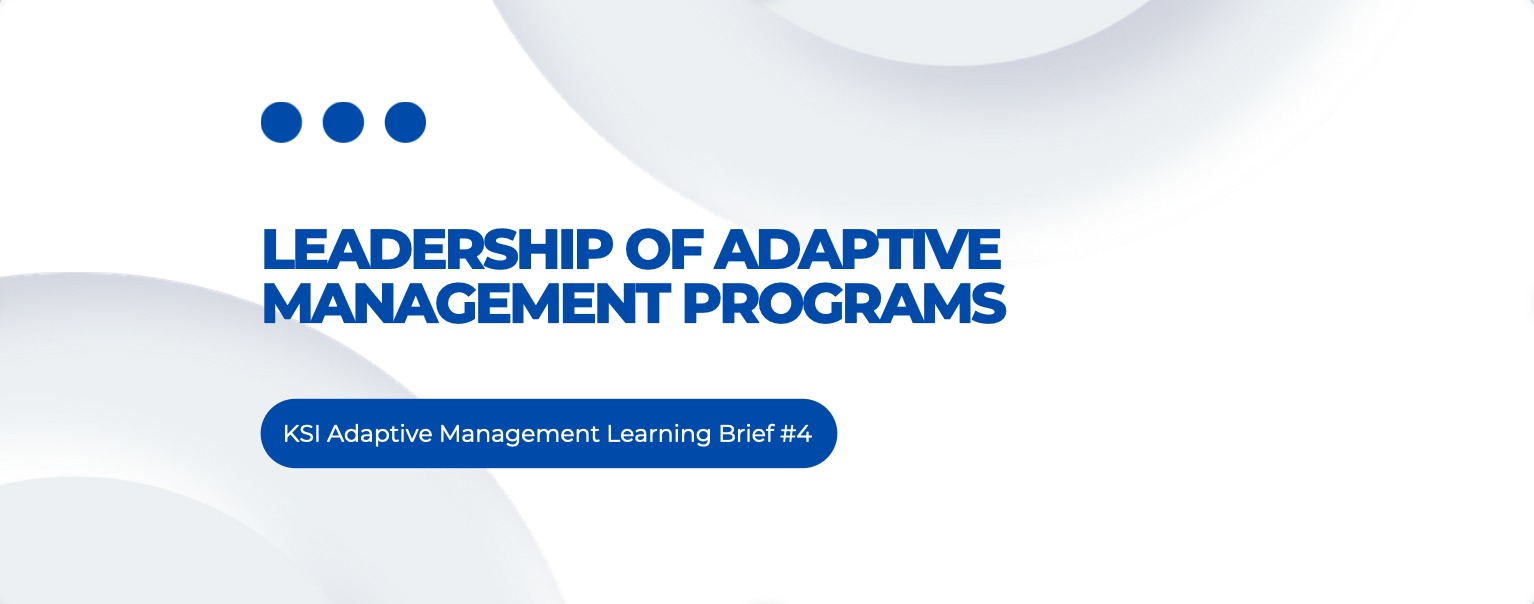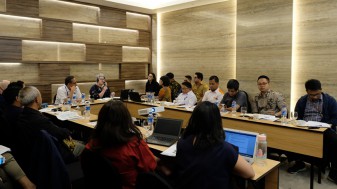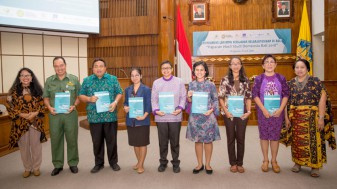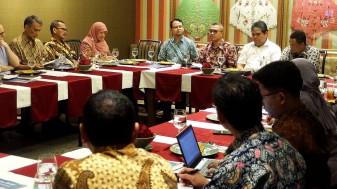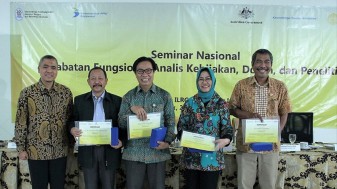KSI Adaptive Management Learning Brief #4[1]
January 2022
Introduction: Different skills for different ways of working
This brief is one in a series of learning documents that capture and share key lessons the Knowledge Sector Initiative (KSI) in Indonesia has learned in its efforts to implement an adaptive management approach during Phase 2 of its operations (2017-2022). These briefs are intended to be practitioner-focused and while there is some reference to the broader literature, our aim is to provide a succinct description of the KSI approach and a set of lessons we hope will be useful to others attempting to implement similar adaptive approaches.
In this brief, we explore key issues relating to leadership of adaptive programs.[2] Leadership as it relates to the recent proliferation of adaptive programming in development has often been looked at through the lens of local leadership (Booth and Unsworth, 2014).[3] There has been a strong push in some quarters of the development community to give greater recognition to the importance of local leadership and to think differently about the role of development assistance as facilitative rather than directly delivering results, though such approaches can be in tension with recognized pressures to claim attribution.
Certainly, lessons regarding the importance of local leadership and of the related idea of thinking about programs as facilitators resonate with the KSI experience. The program has worked with, relied upon, learned from, and aimed to support partners throughout the policy making process. Local leaders have been found across the traditional distinctions between knowledge producer/user/intermediary, evidence demand and supply, government and non-government. Where those partnerships have been founded on genuine interests and incentives, they have been far more effective than what any program could have achieved on its own.
There is, of course, variation in how different ‘adaptive programs’ are structured. Some place the staff of a managing contractor or other implementing organization directly in the role of reformer, while others utilize one or more layers of arms-length relationships, structured through granting or sub-contracting arrangements. However, at least at present, leadership is not something that is fully outsourced to partners. In practice, KSI and other donor-supported interventions continue to maintain some semblance of a program structure and thus leadership of those structures also remains a relevant consideration. Even programs that consider themselves as facilitators and catalysts rather that ‘doers’, are not carrying out simple, established technical processes as they make judgements about the various workstreams within the program.
As donors and their implementing partners increasingly recognize the complexity and dynamism of institutional reform processes, some of these organizations have started to embrace the notion of their work as portfolios of investments aimed at finding new solutions to complex problems, solutions that are not only technically sound, but also politically feasible and thus tailored to context.[4] Portfolios can exist at different levels, but at the program level, this implies an approach that is trying out different strategies, learning through implementation, and subsequently dropping, expanding, changing or continuing those efforts. We find this requires not only new systems and processes, but also different skills and approaches to leadership. In this note we explore the latter, focusing on the lessons learned about leadership of adaptative programs.
KSI’s ‘portfolio’: a practical description
Throughout its second phase, KSI’s portfolio consisted of an evolving set of Key Initiatives (Figure 1). While the program’s intended end of program outcomes (EOPOs) remained consistent, KIs could be added, adjusted or ended. Specific criteria laid out in the Program Implementation Strategy required initiatives to:
- Be necessary (though not necessarily sufficient) to achieve the EOPOs and relevant to program focus areas;
- Allow KSI to play a catalytic role and promote systemic change across the knowledge sector;
- Be feasible in terms of a clear likelihood of contributing to change;
- Build upon KSI experience and assets.
Figure 1: KSI Strategic Pathways
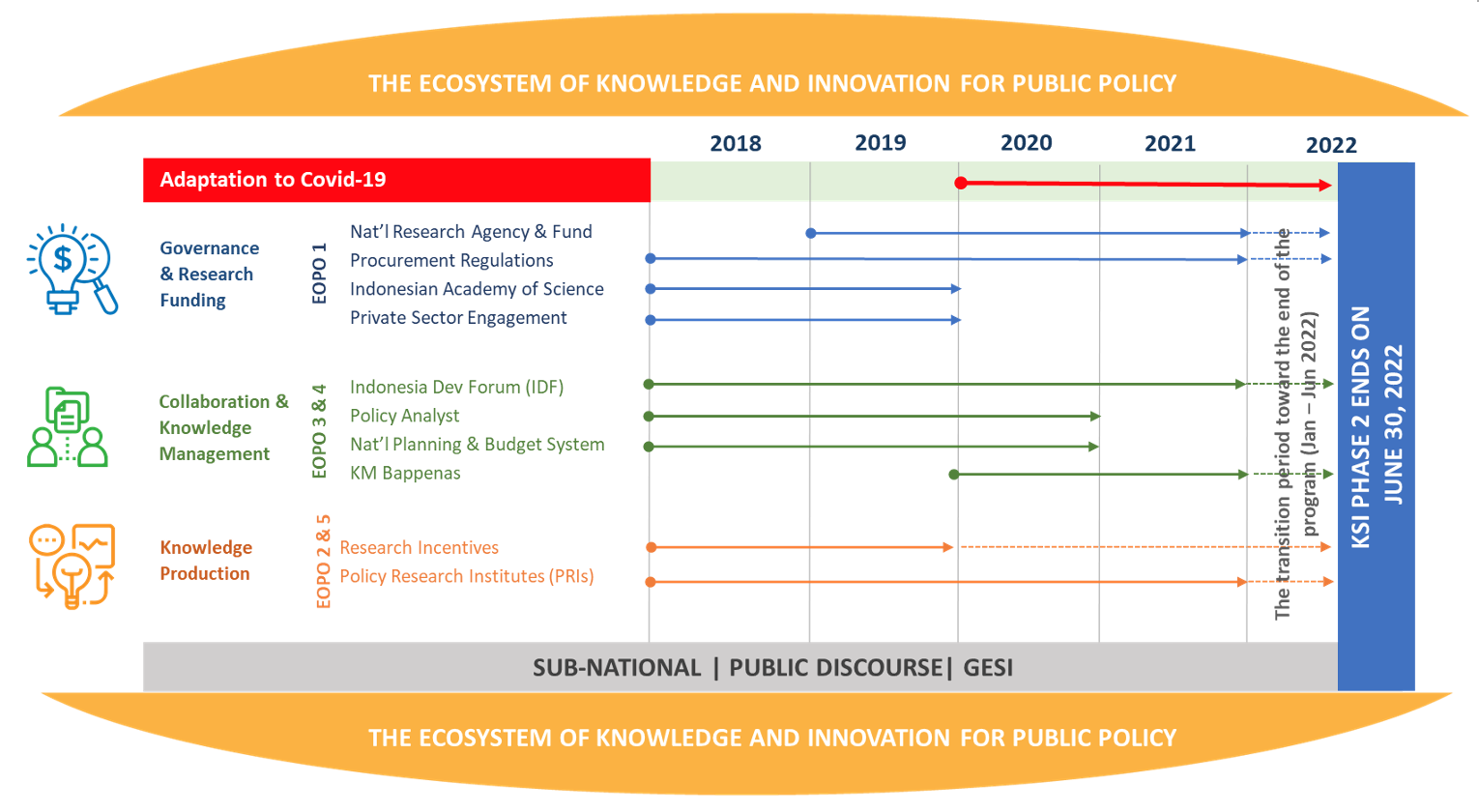
However, while these criteria were helpful prompts for thinking about the trajectory of different initiatives, they fail to fully capture what was being asked of program leadership. Decision-making was not simply a matter of individual trajectories, but a prioritization process that tracked the balance of efforts and potential returns across the different outcome areas through the lens of finite program resources. The question was not simply ‘Are we making progress?’, but ‘Are we making enough progress, towards something of sufficient importance, that we are better off continuing to invest here given the alternatives available?’.
Key lessons for practitioners
In the remainder of this brief, we focus on five lessons we feel will be most useful for leaders to keep in mind as they grapple with these challenging tradeoffs.
- Program leaders need to see the whole program: While this statement might seem obvious at first, it can require a concerted effort to ensure that adaptive systems and processes are supporting not only but are also informing an understanding of how the program can and should evolve as a whole. A portfolio in this sense is not simply a collection of things, but also an understanding of the relationship between these things, including the composition of high-risk and low-risk investments, the balance between predictable and potentially irregular disbursement, and opportunities for cross-learning and learning generated by pursuing parallel tracks.[5] This requires a different perspective, something analysis of adaptive leadership in the private sector has referred to as ‘the view from above the dance floor’,[6] and which became known in KSI as the ‘helicopter view’.
Whatever your metaphor, developing this critical leadership perspective benefitted from a number of things. Firstly, it required having key leadership figures across program governance mechanisms, including implementer, donor, and government, to have the explicit remit, intent and sufficient opportunity (e.g. in duration of tenure) to develop and debate this perspective. Secondly, it depended on recognizing that as a leader your information needs are different from those that are working day-to-day on each initiative, just as your role and responsibilities are different from the initiative lead or other program staff. The Learning Week and KSI/GoI/DFAT progress review sessions that followed sessions described in the companion brief on hard systems gave implementing staff the opportunity to reflect on progress, consider their prospects and make adjustments, but leaders not only ensured these sessions took place, but proactively participated in almost all sessions with an ear for different information as a complement to what they heard in day-to-day operations. Practically, this meant not just an assessment of progress and prospects, but linking that assessment to resourcing (human and financial), and adopting a comparative lens. - Share the vision: Not only is it necessary for leadership to develop and maintain a helicopter view, those working on individual tasks as well as those funding the portfolio may also want to know ‘what it all adds up to’. Leaders of adaptive programs therefore must be adept at telling the story of the program, even where the constituent elements of that program may be shifting. There is a challenge, however, in the tension that emerges between sharing this high-level narrative with various internal and external audiences, and the need to preserve space for experimentation and potential dead ends along the way. The more tightly the vision from above is refined, the harder it can be to maintain flexibility and preserve space for adaptation. Programs can feel pressure to define the very type of comprehensive blueprint that adaptive approaches are intended to avoid, and where a portfolio includes a number of initiatives across a system to deliver that entire blueprint. One job of an effective leader is in part to mitigate the more pernicious effects of ‘fix the whole system’ expectations while still being able to tell a coherent story of how the parts fit together.
- Build a team culture that supports adaptation: The companion brief on the human side of adaptation talks about the need to build a team culture defined by collective ownership and depersonalized criticism. Certainly, there is a strong role for leaders in this process, but adaptive leaders need to combine this with a culture that “embraces disequilibrium”.[7] This lack of satisfaction with the status quo means not just identifying development challenges the program seeks to affect, but also conveying that the very structure of the program was subject to change if it would make the program more effective. A huge challenge for leaders who seek to build this type of team culture is to allow for a sufficient level of challenge, discomfort and productive disagreement, while not allowing it to descend into pessimism or organizational panic. KSI’s leaders were able to address this in part through internal processes, like the investment in critical friendship approaches with leaders modelling that directly and calling it out in others when necessary. Perhaps just as importantly, they had the opportunity to leverage external pressures, whether budget issues (Box 1) or events like the COVID-19 pandemic, which posed difficult questions and required the program to reassess its approach
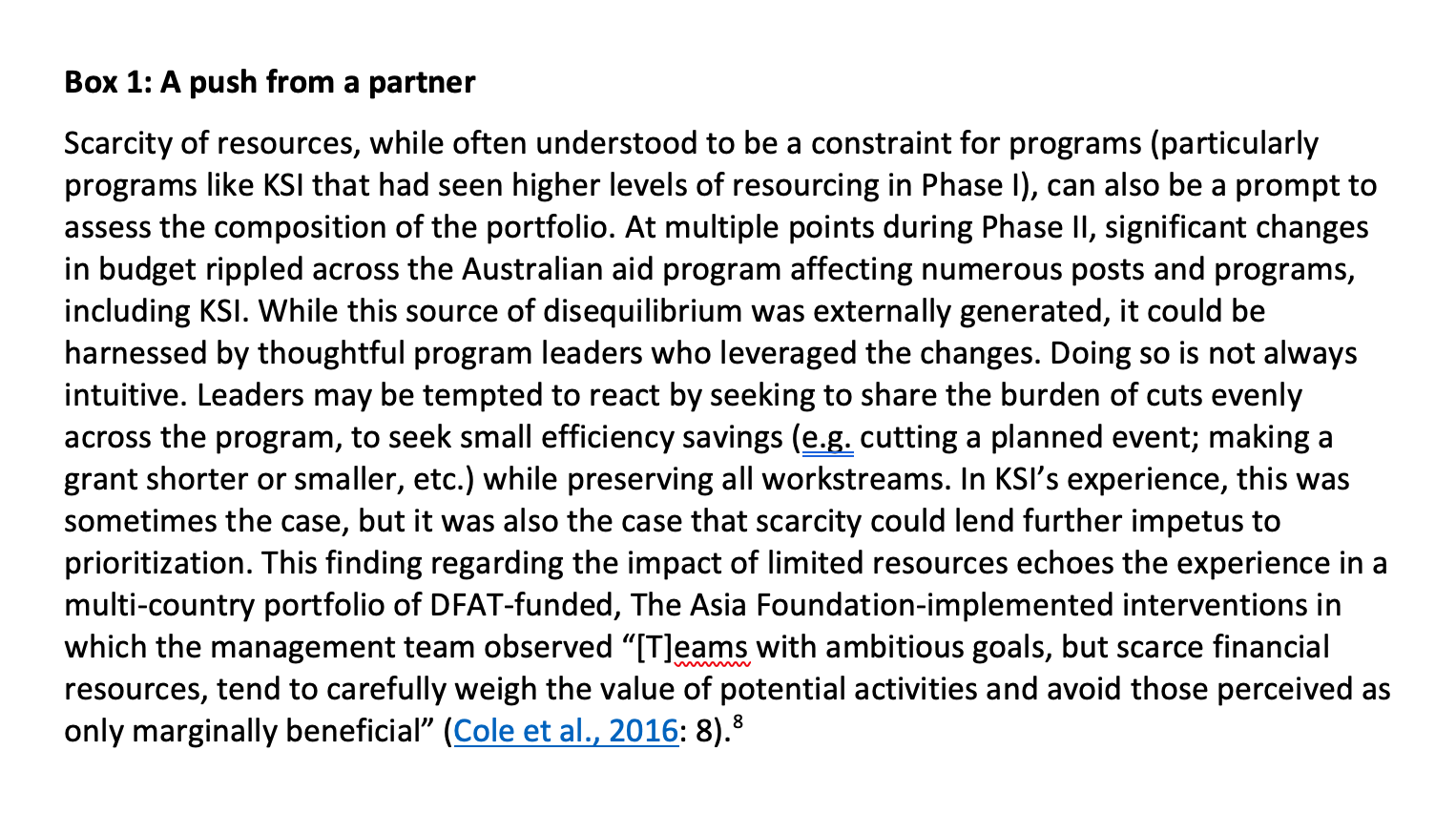
- Practice emotionally intelligent leadership: Those working in development programs have always encountered ups and downs along the way; however, there is a sense in which adaptive programs embrace the fact that a combination of wins and losses is inevitable in even the best run program. That acceptance allows for an awareness of the full spectrum of emotions through which a team might go and requires the leaders of such programs to bring enough, though perhaps not too much, emotion to the workplace. For KSI’s leaders, empathy was a fundamental requirement in guiding the team through the difficulties of adaptation, particularly in the emotionally draining context of the COVID-19 pandemic. When a particular initiative in which the team, including the team leader, had invested considerable time and energy met with an irresolvable political roadblock it was important to be able to show frustrations to staff, but then to modeling the desired behavioral pivot by accepting this evolution and moving on to the next task. At the same time, it is clear that at times, leaders stand apart. Ultimately, it is important to be able to develop and rely upon support networks that extend outside the program,[9] including team leaders or Chiefs of Party of other programs, or family members who can provide support and perspective.
- Generate and share leadership: While program leaders may need to selectively dip into technical detail on occasion, the breadth of larger portfolios require leaders to support the generation and distribution of leadership responsibilities through the delegation of authority to others in the program. This lesson applies across the program structure, including donor controls, corporate controls and program controls. For example, early in Phase 2, KSI and RTI agreed a more streamlined approach and increased financial delegations to the KSI team leader and to the Asia Regional Office (changes agreed with DFAT) without having to get approval from corporate HQ. As Phase 2 progressed, however, the crucial form of delegation became less about budget authority and more about strategic authority. Leaders of individual initiatives were given space to lead based on the detailed technical and political knowledge they held, without the need for complex and cumbersome approval processes. While there was some variation according to the level and capacity of staff, in all cases this delegation is about more than a hands-off assignment. Rather, it requires efforts to actively support staff to make good decisions by using a wide variety of strategies including a baseline, universal open-door policy, the utilization of which depended on establishing relationships of trust within the program,[10] leading by example, and dedicated support to pursue leadership training.
Reflecting broadly on these lessons, much of this discussion and the broader literature on adaptive leadership in the business sphere involves striking a balance between two elements that are seemingly in tension whether that is generating enough discomfort to nudge people to ask difficult questions, but not so uncomfortable as to lead to personal or organizational ‘meltdown’; or bringing enough emotional awareness to manage the real people who work with and within the program, while still maintaining poise, analytical rigor, and professionalism. Along these and other lines, the leaders of adaptive programs must consistently monitor and adjust, turning the temperature up or down as necessary, listening as much as acting, but where they are able to do so effectively, the rewards can be significant.
-----------------------------
[1] These briefs have been written by Daniel Harris with the support of the KSI Performance, Monitoring and Evaluation team, and are based on a program of action research that followed and informed the program’s adaptive management approach.
[2] Companion briefs reflect on the program’s evolving understanding of adaptation, the hard systems and processes put in place to support adaptive processes, and the human side of adaptation.
[3] Booth, D. and Unsworth, S. (2014) Politically smart, locally led development. London: ODI
[4] Pett, J. (2020) Navigating adaptive approaches for development programmes: A guide for the uncertain. ODI Working Paper 589. London: ODI. Examples here include UNDP’s work on portfolios and systems science and the OECD’s exploration of innovation portfolios.
[5] Valters, C., Cummings, C., and Nixson, H. (2016) Putting learning at the centre: Adaptive development programming in practice.London: ODI.
[6] Heifetz, R., Grashow, A., and Linsky, M. (2009) The Practice of Adaptive Leadership: Tools and tactics for changing your organization and the world. Boston: Harvard Business Press.
[7] Heifetz, R., Grashow, A., and Linsky, M. (2009) Leadership in a (Permanent) Crisis. Harvard Business Review (July- August 2009), 62-69.
[8] Cole, W., Ladner, D., Koenig, M., and Tyrrel, L. (2016) Reflections on Implementing Politically Informed, Searching Programs: Lessons for Aid Practitioners and Policy Makers. San Francisco: The Asia Foundation.
[9] Heifetz, R., Grashow, A., and Linsky, M. (2009) Leadership in a (Permanent) Crisis. Harvard Business Review (July- August 2009), 69.
[10] Notably, cases of turnover among program staff, including multiple key leaderships positions, meant trust was something which needed to be nurtured and at times re-established throughout the program.

